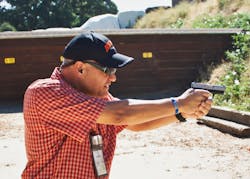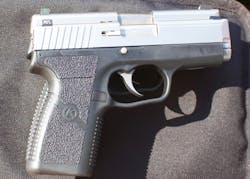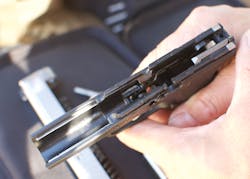A Focused Look at the Kahr P9
I got to test the Kahr P9, a compact 9mm handgun that has excellent ergonomics, handling and concealability. By the end of the test, I decided that I was going to switch and make it my EDC gun.
The Kahr P9 has a 3.9” polygonal rifled barrel with a 1/10 twist, a black polymer frame and a matte stainless slide, which also comes in matte black. It comes standard with 7-round stainless single stack magazines. I like the fact that the P9 has no magazine disconnect and this model came with drift adjustable tritium sights.
Kahr pistols use extensive CNC (computer numerical control) manufacturing processes—they use state-of-the-art CAD/CAM design and 3D modeling. Kahr pistols are known to be consistent in manufacture, which makes repairing and maintaining these particular firearms easy for the agency armorer. If you look at their website, nearly every part can be readily purchased online, which is advantageous to both the consumer and the Kahr-trained armorer. Since there is a platform consistency across the board, once one learns the platform, Kahr handguns are very easy to maintain within a department.
Kahr, like many other manufacturers, publishes a single manual for several of their model types. This is because most models are consistent in design, operation and form factor. The most obvious advantage is having the same operating system throughout each model that allows a department to have a consistent protocol for training.
A small, light, and thin firearm
The most attractive thing about owning a Kahr is the fact that every model is compact, slim and lightweight, bearing the same form factor. The model I tested, a P9, is a single stack, 7+1, trigger cocking DAO that weighs 15 ounces. The overall length is 5.8 inches and the width of the slide is .90 inches. This makes the P9 smaller, lighter and thinner than a Glock 43 or a M&P Shield.
For those carrying the Kahr on a regular basis, they also make a palm-sized, under 10-ounce, 6+1 P380. I was somewhat surprised that the Kahr P9 did not have a captive recoil spring, especially considering the effort it took to compress it for reassembly. It takes a stout recoil spring to absorb the constant hammering of a +P cartridge on a lightweight gun. I recommend field stripping in an area that allows the spring to be found if it goes flying.
The entire fire control system can be accessed from the side plate on the right side of the receiver. It is secured by a screw with a Torx head. In the world of polymer guns, this is a completely original design, and it should dispel any type of suggestion that the Kahr design is “similar to…”.
Kahr uses an external extractor, which is powered by an extractor pin assembly and spring, which is secured by the slide back. This particular design allows the user to quickly inspect the extractor and the armorer to easily change it. By the way, I would call the slide back the rear slide plate cover, but this is how they list it in their online parts catalog.
Out for a field test
We started out our range session with my disassembling the slide completely to see what was under the hood. Field stripping is fairly easy. One simply retracts the slide until a marking on the frame aligns with a marking on the slide. The slide stop is pushed from the right side of the frame, then removed. The recoil spring and spring guide are then removed. Kahr uses a “Browning-type” recoil lug system to tilt the barrel downward as the slide is moving backward. In the Kahr, design is very efficient and reliable.
Kahr describes their Stryker system as a “passive Stryker block”, which includes a striker that looks like a short bolt carrier with the firing pin portion of the Stryker protruding from the front. Inside, there is a mechanism that contacts a striker spacer, striker block spring and a striker block. It’s much simpler than I can describe. Basically, these parts compose an efficient plunger system that prevents the striker from contacting the cartridge unless the trigger is fully to the rear. In use, it proved to be both reliable and smooth. That is, the mechanism itself did not impart any type of additional mechanical feel to the trigger system, like some other striker fired handguns. In fact, the 7-pound trigger didn’t feel like a SAO or a DAO (single or double action only). They call it a trigger cocking DAO, and it is universally satisfying to most users.
After reassembling the pistol, I did a few safety checks, then started shooting at 7 yards. I couldn’t shoot a group using factory ammo under 5 inches. I tried three magazines and nearly set the gun down and prepared it for shipping back to Kahr. We were shooting Nosler 124 JHP Match Grade Ammo and L-Tech 124 Grain CuHP, both reliable performers when it comes to accuracy.
Robert Marvulli, a member of our range testing crew and multiple Kahr owner told me, “You know, the manual says that you have to shoot the gun a couple of hundred rounds before it is broken in.” He owns two other Kahr handguns, and we shoot them often. His P45 is absolutely superior on the range, and we feed it all different kinds of ammo.
We ran a couple of boxes of ammo through the P9, then the groups started to shrink. After a while, we had a gun that could center punch all our paper targets with anything in our ammo inventory.
I guess I should have read the manual first. This gun needs 200 rounds for a break in.
Proven reliability
I had a few rounds of Nosler Match Grade Ammo and the Kahr printed the groups we were looking for in the first place. The L-Tech rounds shot well also.
The grip angle on all Kahrs give the shooter a consistent ability to point. Coupled with its bright, boxy sights, I would bet on the Kahr user against a Pact timer. The Kahr P9 is as simple as it gets. It doesn’t have external safeties. It has a simple, and surprisingly smooth, trigger pull. Its thin profile can accommodate smaller hands and operation is glove-friendly.
I can fit the P9 in a front pocket, as it is well contoured for this purpose. In my opinion it is appropriate for investigations assignments. For a duty belt, the Kahr TP9, a duty-sized version, is a good choice. If smaller is better, the Kahr PM9 is only 5.3 inches overall. I shot one and guess what? It’s a palm-sized version of the P9.
There is an occasional, and often unsubstantiated, complaint that I have heard from Kahr owners that needs to be addressed here. Some users have reported to me that occasionally loaded cartridges fall out of the magazines when they are carried in the pocket. That is, bullets self-strip from these magazines. I haven’t experienced this myself, but we had one Kahr user who experienced this. The magazines functioned just fine, but occasionally a loaded cartridge would fall out without coaxing.
Many magazines allow cartridges to fall out of them, depending on the level of handling. The Kahr magazines are very similar to 1911 style magazines and the contours of the feed lips maintain the balance between feeding and releasing too easily.
There are two recommendations I can give here. First, separate all magazines that do not deliver complete confidence. These will now be practice magazines. Second, rebuild them. The parts are relatively inexpensive. If the magazines are still questionable, they stay in the practice magazine pile.
Kahr magazines are flat, made of stainless steel, and fit well in the back pocket. They slam quickly home when reloading and drop freely when the release is pressed. What’s not to like? Flush and 8-round extended baseplate models are available.
We knew how the P9 would do even before we tested it; one of our crew carries two of them, sometimes at the same time. These guns are workhorses, with proven reliability. Let’s just say that after several years of use, they have not even experienced a hitch in their operation.
The Kahr P9 isn’t just a small handgun appropriate for on and off duty. Potentially, it’s part of a system of handguns that behave exactly the same, using the same form factor and proportions, in different sizes.

Officer Lindsey Bertomen (ret.), Contributing Editor
Lindsey Bertomen is a retired police officer and retired military small arms trainer. He teaches criminal justice at Hartnell College in Salinas, California, where serves as a POST administrator and firearms instructor. He also teaches civilian firearms classes, enjoys fly fishing, martial arts, and mountain biking. His articles have appeared in print and online for over two decades.





